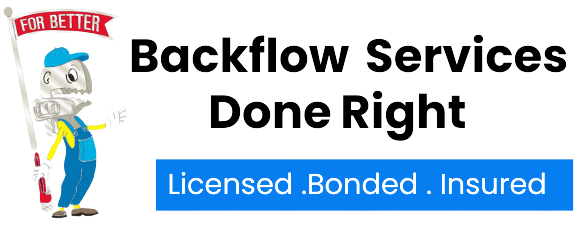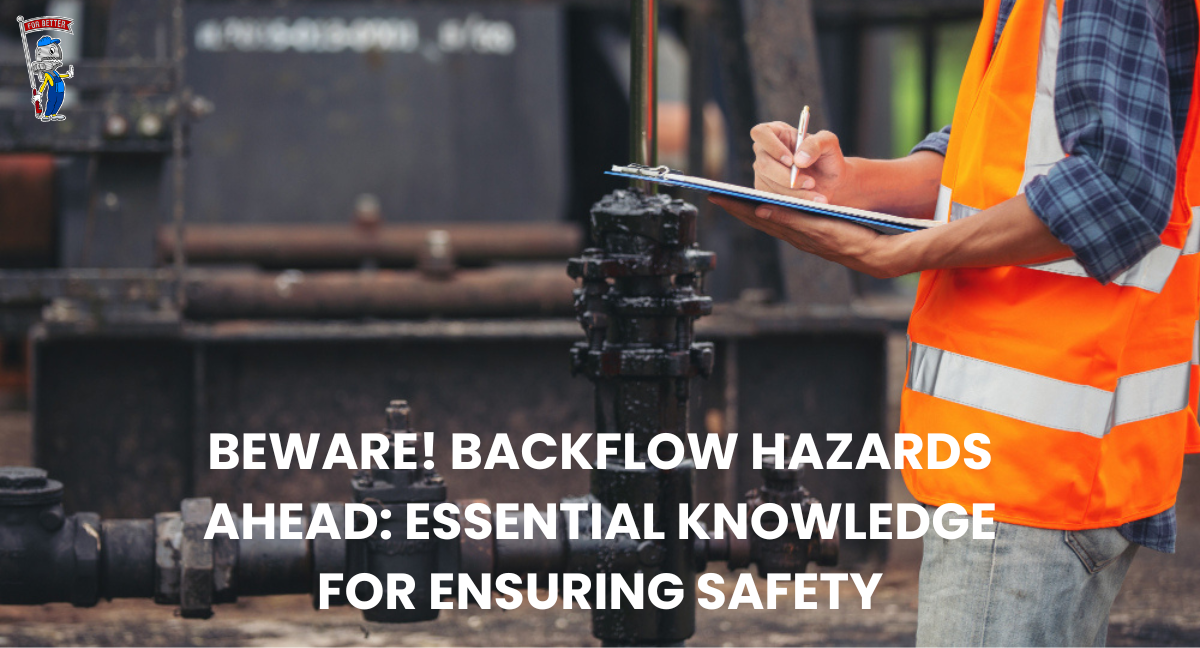Backflow hazards pose a serious risk to public health and safety, yet many people are unaware of the potential dangers they present. In this blog post, we’ll explore types of backflow hazards, why it’s hazardous, and how to prevent backflow incidents to safeguard our water supply.
Types of Backflow Hazards
Back Siphonage
Back siphonage occurs when a sudden drop in water pressure causes water to flow in the opposite direction, pulling contaminants into the water supply. This can happen during firefighting operations, water main breaks, or when a nearby water main is shut off for repairs.
Backpressure
Backpressure occurs when the pressure in the water distribution system exceeds the pressure in a plumbing fixture or appliance, causing contaminated water to be forced back into the clean water supply. This can happen in situations where a boiler, irrigation system, or chemical feed system is connected to the water supply without proper backflow prevention devices.
Cross-Connection
A cross-connection is a physical connection between the potable water supply and a potential source of contamination, such as a garden hose submerged in a swimming pool or a hose connected to a chemical tank. Cross-connections create opportunities for backflow to occur and introduce contaminants into the water supply.
Why is Backflow Hazardous?
Backflow poses significant risks to public health and safety due to the potential contamination of the clean water supply. Contaminants such as bacteria, chemicals, and other pollutants can cause illnesses, infections, and even fatalities if ingested or exposed to the skin or mucous membranes. Backflow incidents can also result in costly cleanup efforts and damage to infrastructure.
Consequences of Backflow Hazards
Backflow hazards pose significant risks to the safety and purity of our water supply. Understanding the potential consequences of backflow incidents is crucial for safeguarding public health and the environment. Now, we’ll explore the various consequences of backflow hazards in easy-to-understand terms, highlighting the importance of preventive measures.
Waterborne Illnesses
One of the most serious consequences of backflow hazards is the potential for waterborne illnesses. When contaminated water flows backward into the clean water supply, it can introduce harmful bacteria, viruses, and parasites. Consuming or coming into contact with contaminated water can lead to gastrointestinal infections, such as diarrhea, vomiting, and stomach cramps, as well as more severe illnesses like cholera, typhoid fever, and hepatitis.
Chemical Contamination
Backflow incidents can also result in the introduction of chemicals and other pollutants into the water supply. This can occur when backpressure forces chemicals from industrial processes, pesticides from agricultural activities, or cleaning agents from residential properties back into the potable water system. Exposure to these contaminants through drinking water or skin contact can cause poisoning, skin irritation, respiratory problems, and long-term health effects.
Damage to Infrastructure
Backflow incidents can cause damage to water distribution infrastructure, including pipes, valves, and pumping stations. The presence of corrosive or abrasive substances in contaminated water can accelerate the deterioration of pipes and fittings, leading to leaks, bursts, and structural failures. Additionally, the accumulation of debris and sediment from backflow events can clog pipes and restrict water flow, reducing system efficiency and increasing maintenance costs.
Legal and Financial Liabilities
Property owners, water utilities, and municipalities may face legal and financial liabilities in the aftermath of backflow incidents. Inadequate backflow prevention measures, negligence, or non-compliance with regulations can result in lawsuits, fines, penalties, and damage claims. Moreover, the costs associated with cleanup, remediation, and public health interventions can be substantial, impacting budgets and resources at both local and national levels.
Public Health Concerns
Backflow incidents can create public health concerns and erode public trust in the safety of drinking water. News of contaminated water supplies can cause panic, confusion, and outrage among affected communities, leading to disruptions in daily life and economic activities. Addressing public health concerns requires timely communication, transparency, and coordinated response efforts to mitigate risks, provide accurate information, and restore confidence in the water supply.
The consequences of backflow hazards extend beyond immediate health risks to encompass environmental, social, legal, and financial implications. By understanding the potential risks and taking proactive measures to prevent backflow incidents, we can protect our water supply, preserve public health, and ensure the sustainability of our communities for future generations. Implementing robust backflow prevention programs, investing in infrastructure upgrades, and promoting awareness and compliance with regulations are essential steps in mitigating the impacts of backflow hazards and building resilient water systems.
Preventing Backflow Hazards
Preventing backflow hazards requires a proactive approach to plumbing system design, installation, and maintenance.
Key prevention measures include:
- Installing backflow prevention devices, such as check valves or backflow preventer assemblies, at critical points in the plumbing system.
- Conducting regular inspections and testing of backflow prevention devices to ensure they are functioning properly.
- Educating property owners, plumbers, and water utility personnel about the importance of backflow prevention and cross-connection control.
- Enforcing regulations and standards related to backflow prevention, including the use of approved backflow prevention devices and compliance with building codes.
Essential Tips For Protecting Your Home from Backflow Hazards
Install Backflow Prevention Devices
One of the most effective ways to protect your home from backflow hazards is to install backflow prevention devices. These devices, such as check valves, backflow preventer valves, and air gaps, create a physical barrier that prevents contaminated water from flowing backward into your clean water supply. Consult with a qualified plumber to determine the most suitable backflow prevention device for your home’s plumbing system.
Regularly Inspect and Maintain Plumbing Fixtures:
Schedule regular inspections and maintenance of your home’s plumbing fixtures to identify and address potential backflow risks. Check for leaks, corrosion, and signs of wear in pipes, valves, and fittings. Ensure that backflow prevention devices are properly installed and functioning correctly. Promptly repair or replace any damaged or malfunctioning components to prevent backflow incidents.
Call us now at Fairfax +1 (703)-250-4200, Arlington +1 (703)-524-1250 to book your inspection.
Avoid Cross-Connections
Minimize the risk of cross-connections, which can create pathways for contaminants to enter your water supply, by implementing proper plumbing practices. Avoid submerging garden hoses in swimming pools, disconnect hoses from outdoor faucets when not in use, and install backflow prevention devices on all hose bibs. Be mindful of any potential sources of contamination, such as irrigation systems or chemical tanks, and ensure they are properly isolated from your potable water supply.
Maintain Adequate Water Pressure
Maintain adequate water pressure in your home’s plumbing system to prevent backflow incidents due to back pressure. Ensure that pressure-reducing valves are installed and functioning correctly to regulate water pressure and prevent excessive pressure buildup. Monitor water pressure regularly and address any fluctuations or abnormalities promptly to avoid potential backflow risks.
Educate Yourself and Your Family
Educate yourself and your family members about the risks of backflow hazards and the importance of proper backflow prevention measures. Teach them how to identify potential sources of contamination, recognize signs of backflow risks, and take appropriate preventive actions. Encourage everyone to report any plumbing issues or concerns to you or a qualified professional promptly.
Comply with Local Regulations and Codes
Familiarize yourself with local regulations and building codes about backflow prevention and cross-connection control. Ensure that your home’s plumbing system meets all requirements for backflow prevention devices, installation practices, and maintenance procedures. Stay informed about any updates or changes to regulations and ensure compliance to protect your home and water supply.
Conclusion
Protecting your home from backflow hazards is essential for ensuring the safety and purity of your water supply. By following these practical tips and preventive measures, you can minimize the risk of backflow incidents and safeguard the health and well-being of your family. Invest in backflow prevention devices, and backflow prevention services, maintain your plumbing system regularly, avoid cross-connections, educate yourself and your family, and comply with local regulations to protect your home from backflow hazards effectively.



